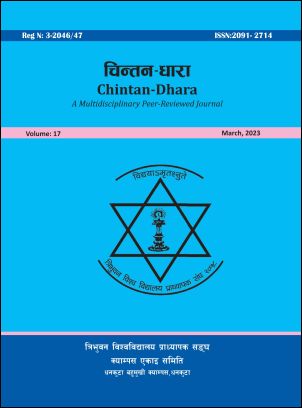विश्वेश्वरप्रसाद कोइरालाका उपन्यासमा जनजाति महिला पात्र/चरित्र {Tribal women characters/roles in the novel of Vishweshwar Prasad Koirala}
DOI:
https://doi.org/10.3126/cd.v17i01.53269Keywords:
शीर्ष (main), भूमिका (role), जनजाति (tribe), महिला पात्र (woman character)Abstract
विश्वेश्वरप्रसाद कोइराला लिखित अघिल्ला तीन उपन्यास हुन् ः तीनघुम्ती, सुम्निमा र नरेन्द्र दाइ । यी तीन उपन्यासमा प्रमुख÷शीर्ष एवम् मुख्य महिला पात्रका रूपमा जनजातीय इन्द्रमाया, सुम्निमा र मुनरिया प्रस्तुत छन् । उपन्यासकारले आप्mना विशिष्ट औपन्यासिक कृतिहरूमा यस प्रकारका पात्रहरूको छनोट गरिनु वास्तविक रुपमा नै आवश्यक हो या अन्य कुनै प्रयोजन प्रेरित भएर छनोट गरेका हुन् ? भन्ने समास्यामा आधारित भई त्यसको मूल अभिप्राय पत्ता लगाउने उद्देश्यमा प्रस्तुत लेख केन्द्रित छ । द्वितीयक वा पुस्तकालयीय सामग्रीमा आधारित यो लेख पूर्णतया गुणात्मक एवम् विश्लेणात्मक पद्धतिमा आधारित छ । उपन्यासमा आएका सबै जनजाति महिलाका प्रियतमका रूपमा ब्राह्मण परिवारका पुरुष आएका छन् र तीनै प्रियाले स्वच्छ हृदयले आत्मिक प्रेम गरेको पनि छर्लङ्गिन्छ । इन्द्रमायाले प्रियातत्व र पत्नीत्व प्राप्त गरे पनि मातृत्वमा खुम्चिएर आप्mनो अस्तित्वको संरक्षण गरेकी, मुनरियाले अल्पकालीन प्रियत्वको प्राप्तिमा भाग्यमानी ठान्दै भवितालाई स्वीकारेर आफूलाई जौहारीलाललाई सुम्पेकी र सुम्निमाले भौतिक रूपमा अप्राप्य सोमदत्तबाट शारीरिक रूपमा आफूलाई सुरक्षित गरे पनि मानसिक दृष्टिले शोसित बन्नु परेको कुरा तथ्यले दर्शाउँछ । औपन्यासिक उद्देश्यका दृष्टिले सुम्निमालाई जनजातीय महिलाको रुपमा प्रस्तुत गर्नु उपयुक्त देखिए तापनि इन्द्रमाया र मुनरियाका स्थानमा ब्राह्मण, क्षेत्री परिवारका महिला पात्रलाई स्थान दिइएको भए सायद यस प्रकारको प्रश्न नउठ्ने वा यी दुई पात्रमध्ये एक जनजातीय र एक अन्य रहेको भए पनि स्वाभाविक मान्न सकिने तथ्य अध्ययनले प्रस्तुत गर्दछ । त्यसैले जनजातीय पात्र चयनमा नै लेखकीय दुराशयता प्रष्टिन्छ र तीनै उपन्यासका जनजातीय महिला पात्रहरू आर्य प्रियतम वरण गरेर थिलथिलिएका र त्यसले जनजातीय जिउँदोपनलाई घोचिरहेको निष्कर्ष प्रस्तुत गरेको छ ।
(The previous three novels written by Vishweshwar Prasad Koirala are Tingghumti, Sumnima and Narendra Dai. These three novels feature Indramaya, Sumnima and Munaria as the main female characters. Is it really necessary for the novelist to choose these types of characters in his specific fictional works or did he choose them inspired by some other purpose? Based on this problem, the present article is focused on the purpose of finding out its original intention. This article based on secondary or library material is completely based on qualitative and analytical method. In the novel, men from Brahmin families have come as the lovers of all tribal women and it is also shown that all the three Priyas have spiritual love with pure hearts. The facts show that although Indramaya gained love and wifehood, she protected her existence by shrinking into motherhood, Munaria considered herself lucky to get a short-term love and accepted Bhavita and handed herself over to Joharilal, and Sumnima protected her physically from the physically unattainable Somdatta, but she had to become mentally ill. Although it seems appropriate to present Sumnima as a tribal woman from the point of view of the novel, the study presents the fact that if a female character from a Brahmin, Chhetri family was placed instead of Indramaya and Munaria, perhaps this kind of question would not arise or even if one of these two characters is tribal and the other is natural, the study presents the fact. Therefore, the selection of tribal characters shows the writer's indolence and it is concluded that the tribal female characters of all the three novels were chosen as Arya Priyatam and that this is destroying the tribal vitality.)




